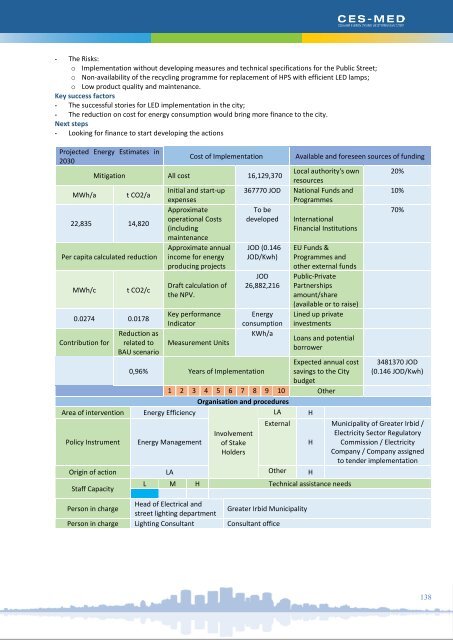171117_SECAP of Greater Irbid Municipality_SET_rev2
Create successful ePaper yourself
Turn your PDF publications into a flip-book with our unique Google optimized e-Paper software.
3. PROJECT DEVELOPMENT/COMMERCIAL ASPECTS<br />
- Project implementation plan – Level 1 (minimum) including a Gantt chart laying out the project timeline, resource<br />
requirements, project development budget, procurement concept (e.g., full turnkey or multi contracting approach),<br />
and O&M concept.<br />
- Option agreements for land access for all privately held land or access roads, or a concession agreement with the<br />
relevant authority.<br />
- Evaluation <strong>of</strong> the commercial structure <strong>of</strong> the project. This includes evaluating the project company or companies,<br />
which may involve a Special Purpose Vehicle (SPV), depending on company structures allowed under local law. This<br />
also includes evaluating any <strong>of</strong>f-shore parent-company structures and incorporation location based on legal, financial<br />
and tax criteria corresponding to the project.<br />
- Investment and funding requirements and the investment concept. This should include equity contribution amounts<br />
and sources, equity partner requirements and financing assumptions to be included in the financial model.<br />
- A project structure and risk-mitigation strategy. In many emerging markets, to make a project “bankable” (i.e., able to<br />
attract reasonably-priced debt financing) it is typically necessary to secure credit enhancements, which can be either<br />
private (letters <strong>of</strong> credit, escrow accounts) or governmental (sovereign guarantees).<br />
- Procurement <strong>of</strong> Owner’s Engineer. As the intention to proceed with the project grows, so too the technical scope for<br />
the EPC or other technical tendering procurement contracts needs to be drafted and reviewed by the Owner’s<br />
Engineer. The EPC’s Owner’s Engineer scope <strong>of</strong> work may also include support for the technical procurement (e.g., PV<br />
plant components) and technical design review. The same firm usually follows through as the Owner’s Engineer during<br />
the construction phase.<br />
- Tender and award <strong>of</strong> Owner’s Counsel to support contracts development and negotiation as well as any relevant legalstructuring<br />
needs and company set-up during the development phase.<br />
STAGE 4 – PERMITTING, CONTRACTS AND FINANCING<br />
After the feasibility stage and assuming that the project still seems to be financially viable, the project moves to the next<br />
stage. This includes obtaining final permits, securing project finance and pre-implementation activities (commercial<br />
contracts). The timing and sequencing <strong>of</strong> this stage will vary significantly by project, but this phase usually includes the<br />
following activities:<br />
1. Engagement <strong>of</strong> relevant community or stakeholders.<br />
2. Preparation and submission <strong>of</strong> relevant permit and licence applications and associated documents for the proposed<br />
project.<br />
3. Environmental and social assessments (agreed in consultation with permitting authority and other statutory bodies),<br />
which may include a full Environmental and Social Impact Assessment (ESIA).<br />
4. Preparation and submission <strong>of</strong> a grid connection application.<br />
5. Review <strong>of</strong> the design and any permit/consent conditions; revision <strong>of</strong> design or consents as needed.<br />
6. Contractor prequalification, ranking, and short list selection.<br />
7. Decision on the financing approach (e.g., sources and proportions <strong>of</strong> equity and debt, including construction financing).<br />
8. Securing financing for the project.<br />
9. Decision on contracting strategy (i.e., EPC contract or multi-contract).<br />
10. Preparation <strong>of</strong> solar PV module tender documentation. Supplier/contractor selection and contract negotiations.<br />
11. Preparation <strong>of</strong> construction or balance <strong>of</strong> plant tender documentation.<br />
12. Preparation <strong>of</strong> PPA documentation and final negotiations.<br />
13. Preparation <strong>of</strong> O&M concept and contracts, as relevant.<br />
14. Preparation <strong>of</strong> Owner’s Engineer tender (if technical advisor is not continued into construction).<br />
15. Contracting and procurement <strong>of</strong> relevant insurances (i.e., construction, operation, etc.).<br />
16. Preparation <strong>of</strong> Lender’s Engineers and Lender’s Council tenders.<br />
17. Finalisation <strong>of</strong> grid interconnection agreement with grid operator or relevant authority.<br />
18. Preparation <strong>of</strong> detailed, bankable financial model covering the full lifecycle <strong>of</strong> the plant. Typically this will only be<br />
completed after negotiating the EPC or equipment and Balance <strong>of</strong> Plant (BoP) contracts, as well as O&M contracts, so<br />
that the financial model can incorporate final costs <strong>of</strong> capital and O&M.<br />
19. Completion <strong>of</strong> a project risk analysis.<br />
131

















